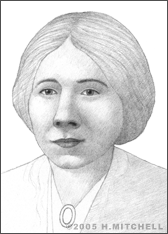Florence Lawrence
It wasn’t an engineer, an auto mechanic, or a scientist who came up with two of the most indispensable early automobile innovations that are now included on every car today. Rather, it was a Hollywood starlet, Florence Lawrence, who created the first turn indicator as well as the full-stop signal activated by applying the footbrake.
Lawrence was born Florence Annie Bridgwood in Hamilton, Ontario, Canada on January 2, 1886. Her mother, a vaudeville actress, had changed her name from Charlotte Bridgwood to Lotta Lawrence. She later changed her daughter’s surname, too, as the pair traveled together on the showbiz circuit, and Florence became known as “Baby Flo, The Child Wonder Whistler.”
Lawrence got her first film part in 1907 in “Daniel Boone” and went on to make more than 250 films. At first, most of them were short, small-time productions known as “one-reelers,” which were typically shot in one week or less. At this time, credits were not terribly important, and Lawrence worked anonymously. She became widely known for her face, however, as “The Biograph Girl,” named after the film studio she typically worked for.
Carl Laemmle, who founded Universal Pictures, formed his own film house in 1910, named the IMP Company. He convinced Lawrence to become the studio’s leading actress, luring her in through money and publicity stunts. This helped to spur the movie star system that we know so well today. For this reason, Lawrence is often called the first real “movie star.”
Also during this period, automobiles were just becoming widely available, and Lawrence, having the funds to be able to buy one of these very expensive machines, was among the fortunate few to own her own car as early as 1913.
She was a truly passionate automobile enthusiast who believed that cars responded best to proper care and communication, and she had many ideas for improving them. She began inventing a number of improvements and accessories. The first of these was the “auto signaling arm,” which is known as the first version of a turn signal. Her variation was an arm placed on the back of the car’s fender that could be activated to rise or lower with the push of buttons located by the driver’s seat to indicate the driver’s intention to turn left or right. Another feature was a sign for indicating “full stop,” which was raised or lowered at the car’s rear simply by pressing on the footbrake.
Lawrence never patented her inventions, but improved versions were soon seen all over. By 1939, the Buick made electrical turn signals standard in all of its cars. Her mother patented a system of electrical windshield wipers in 1917. Neither made any money off of their invention. Meanwhile, Lawrence was replaced at IMP by Mary Pickford, and she left to work for Lubin studios. She and her husband, Harry Solter, started their own studio, Victor Film Company, in 1912 and sold it to Universal Pictures in 1913.
By 1915, after suffering an injury in a fire and then facing the death of her husband in 1920, Lawrence began to drop out of the film scene and found herself in less and less demand. She married again and lost her second husband in 1930; a third marriage lasted less than one year. Tragically, Lawrence committed suicide in 1938 in Beverly Hills, Calif.


